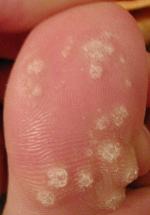
Back Vrat Afrikaans Vorruca AN ثؤلول Arabic Verruga AST ЦӀинкир AV Ziyil Azerbaijani Kulugo BCL Бародаўка Byelorussian Бародаўка BE-X-OLD Брадавица Bulgarian
| Wart | |
|---|---|
| Other names | Verrucae,[1] papillomas[2] |
 | |
| A large number of warts on the big toe | |
| Specialty | Dermatology |
| Symptoms | skin growth usually occurring on the hands, feet, or genitals[1][3] |
| Duration | Months to years[1] |
| Causes | Human papillomavirus[1] |
| Risk factors | Public showers and pools, eczema[3] |
| Differential diagnosis | Callus, seborrheic keratosis, squamous cell carcinoma[4] |
| Prevention | Avoiding skin contact with infected individual, not walking barefoot in public areas, having safe sex or sexual abstinence |
| Treatment | Salicylic acid, cryotherapy,[1] surgical removal |
| Frequency | Very common[2] |
Warts are non-cancerous viral growths usually occurring on the hands and feet but which can also affect other locations, such as the genitals or face.[1][3] One or many warts may appear.[3] They are distinguished from cancerous tumors as they are caused by a viral infection, such as a human papillomavirus, rather than a cancerous growth.[3]
Factors that increase the risk include the use of public showers and pools, working with meat, eczema, and a weak immune system.[1][3] The virus is believed to infect the host through the entrance of a skin wound.[1] A number of types exist, including plantar warts, "filiform warts", and genital warts.[3] Genital warts are often sexually transmitted.[5]
Without treatment, most types of warts resolve in months to years.[1] A number of treatments may speed resolution, including salicylic acid applied to the skin and cryotherapy.[1] In those who are otherwise healthy, they do not typically result in significant problems.[1] Treatment of genital warts differs from that of other types.[3] Infection of a virus, such as HIV, can cause warts. This is prevented through careful handling of needles or sharp objects that could infect the individual through physical trauma of the skin, plus the practice of safe sex, and sexual abstinence. Viruses that are not sexually transmitted, or are not transmitted in the case of a wart, can be prevented through a number of behaviors, such as wearing shoes outdoors and avoiding unsanitized areas without proper shoes or clothing, such as public restrooms or locker rooms.
Warts are very common, with most people being infected at some point in their lives.[2] The estimated current rate of non-genital warts among the general population is 1–13%.[1] They are more common among young people.[1] Prior to widespread adoption of the HPV vaccine, the estimated rate of genital warts in sexually active women was 12%.[5] Warts have been described as far back as 400 BC by Hippocrates.[4]
- ^ a b c d e f g h i j k l m Loo SK, Tang WY (12 June 2014). "Warts (non-genital)". BMJ Clinical Evidence. 2014. PMC 4054795. PMID 24921240.
- ^ a b c "Papillomas (Warts) – National Library of Medicine". PubMed Health. Archived from the original on 10 September 2017. Retrieved 6 November 2016.
- ^ a b c d e f g h "Warts: Overview". U.S. National Library of Medicine. 30 July 2014. Archived from the original on 10 September 2017.
- ^ a b Bope ET, Kellerman RD (2012). Conn's Current Therapy 2012. Elsevier Health Sciences. p. 275. ISBN 978-1-4557-3305-7. Archived from the original on 7 November 2016.
- ^ a b W Buck H (13 August 2010). "Warts (genital)". BMJ Clinical Evidence. 2010. PMC 3217761. PMID 21418685.
© MMXXIII Rich X Search. We shall prevail. All rights reserved. Rich X Search